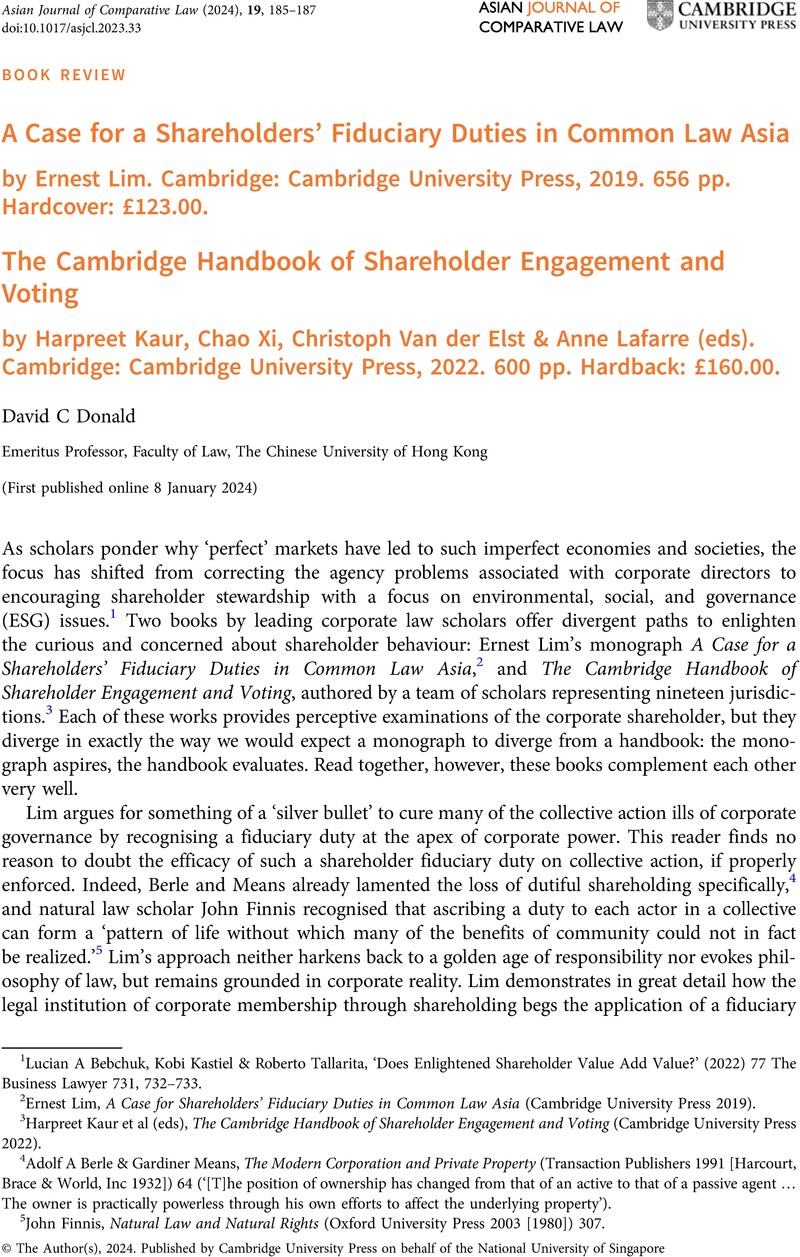No CrossRef data available.
Published online by Cambridge University Press: 08 January 2024

1 Bebchuk, Lucian A, Kastiel, Kobi & Tallarita, Roberto, ‘Does Enlightened Shareholder Value Add Value?’ (2022) 77 The Business Lawyer 731, 732–733Google Scholar.
2 Lim, Ernest, A Case for Shareholders’ Fiduciary Duties in Common Law Asia (Cambridge University Press 2019)CrossRefGoogle Scholar.
3 Kaur, Harpreet et al (eds), The Cambridge Handbook of Shareholder Engagement and Voting (Cambridge University Press 2022)CrossRefGoogle Scholar.
4 Berle, Adolf A & Means, Gardiner, The Modern Corporation and Private Property (Transaction Publishers 1991 [Harcourt, Brace & World, Inc 1932]) 64Google Scholar (‘[T]he position of ownership has changed from that of an active to that of a passive agent … The owner is practically powerless through his own efforts to affect the underlying property’).
5 Finnis, John, Natural Law and Natural Rights (Oxford University Press 2003 [1980]) 307Google Scholar.
6 Lim (n 2) 25 et seq.
7 ibid 205 et seq.
8 ibid 3.
9 ibid 11.
10 ibid 39.
11 As Leonard explains, ‘Between 2007 and 2017, the Fed's balance sheet nearly quintupled, meaning it printed about five times as many dollars during that period as it printed in the first hundred years of its existence. All those dollars were forced into a zero-interest-rate world, where anybody was punished for saving money. It was impossible to trace the path of each QE [Quantitative Easing] dollar released in the flood of $3.5 trillion … This money flowed out into the system, and it pushed all the major financial institutions to search for yield. Many Wall Street traders … developed a nickname for it: the “everything bubble.”’ (Christopher Leonard, The Lords of Easy Money: How the Federal Reserve Broke the American Economy (Simon & Schuster 2022) 211–212). ‘All told, QE programs started with QE2 in 2010 expanded the size of the Fed's balance sheet from $2.3 trillion to $8.2 trillion and rising in mid-2021.’ (ibid 349).
12 Chao Xi & Anne Lafarre, ‘Shareholder Voting and Engagement: An Introduction’, in Harpreet Kaur et al (eds), The Cambridge Handbook of Shareholder Engagement and Voting (Cambridge University Press 2022) 3.
13 ibid 4.
14 ibid 8.
15 ibid 14.
16 ibid.
17 Thomas, Randall S, Giudici, Paolo & Varottil, Umakanth (eds), Research Handbook on Shareholder Inspection Rights: A Comparative Perspective (Edward Elgar Publishing 2023)CrossRefGoogle Scholar.
18 Xi, Chao, ‘Shareholder Engagement and Voting: Where Does the Future Lie?’, in Kaur, Harpreet et al (eds), The Cambridge Handbook of Shareholder Engagement and Voting (Cambridge University Press 2022) 537Google Scholar.
19 Möslein, Florian & Rennig, Christopher, ‘Shareholder Engagement in Germany’, in Kaur, Harpreet et al (eds), The Cambridge Handbook of Shareholder Engagement and Voting (Cambridge University Press 2022) 308Google Scholar.
20 Khanna, Vikramaditya S, ‘Shareholder Engagement in the United States’, in Kaur, Harpreet et al (eds), The Cambridge Handbook of Shareholder Engagement and Voting (Cambridge University Press 2022) 239Google Scholar.
21 Lim (n 2) 475.
22 ibid 475.
23 Xi (n 18) 545.